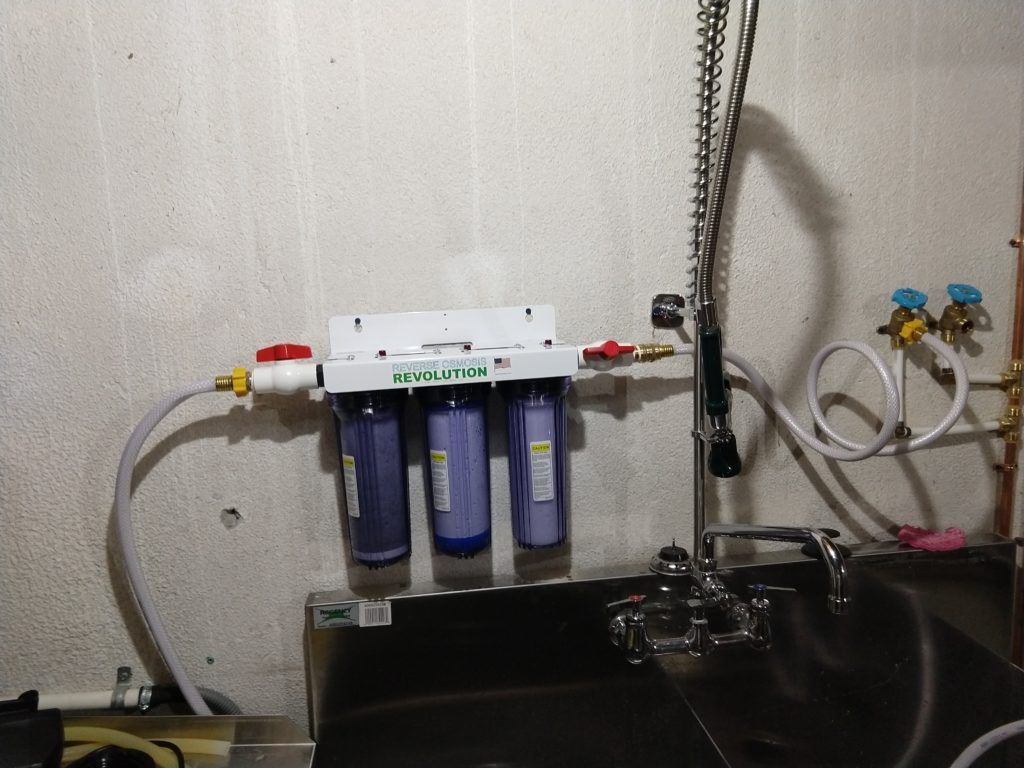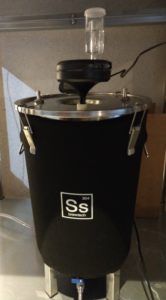
This review is by Homebrew Finds Contributor Brad Probert. Brad is an engineer, expert homebrewer and experienced reviewer. Grab a link to Brad’s website at the end of this review.
Update: Brew Perfect/Beer Bug has been discontinued, consider TILT
Hands on Review: TILT Bluetooth Hydrometer

Brew Perfect WiFi Hydrometer
There are people say that you don’t need continuous data logging of gravity of your fermenting beer. I can almost guarantee you those are people that have never done it. By logging, you get access to a lot of information you don’t otherwise have, which allows you to know certain things better.
First is detecting the start of fermentation. If you’re just looking at airlock activity, you don’t know if a lack of activity is a leak somewhere, or the yeast that haven’t started yet. Or maybe your temperature is just a bit too low. By tracking the gravity, you can tell when the actual sugar conversion to alcohol has started.
To determine when fermentation is finished, you could gauge by airlock activity. But I can now tell you confidently that airlock activity goes on well past the point when the gravity is finished dropping. Of course you could take gravity readings and look for 3 days with the same reading. However, what works better is being able to distinguish the flat line after tracking gravity throughout your fermentation. This is a pretty clear signal that’s detectable before that 3 day sampling. Tracking gravity, I can see most of my beers are finished in a matter of days, with the longer ones being maybe just over a week.
The final benefit I’ve seen is that I can tell based on gravity changes when I’m headed toward a stalled/stuck fermentation. There have been multiple occasions where I see a nice steady gravity drop start to slow down and flatten out before I’m near the expected FG. With data logged every 15 minutes, you can see these trends as they’re happening. And then you can react by bumping up the fermentation temperature.
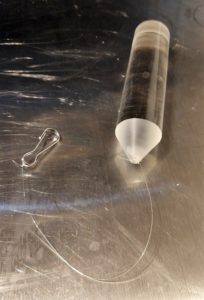 Brew Perfect Gravity Torpedo
Brew Perfect Gravity Torpedo
The physics that make the Brew Perfect work have to do with buoyancy. There is a heavy cylindrical plastic rod that they call their “gravity torpedo” that dangles down, submerged in your wort. This hangs on fishing line clipped to a loop coming out of the base unit. The buoyancy forces that want to push this up in the wort are proportional to the density of the wort. By measuring the force on the fishing line, the Brew Perfect can estimate the density/gravity of the wort. An important note for those of us that like to do batches less than 5 gallons, is the torpedo has to be completely submerged in the wort in order to get accurate readings. So you need to either match the fermentor size close to your batch size, or figure out some fishing line extensions to let your torpedo hang lower.

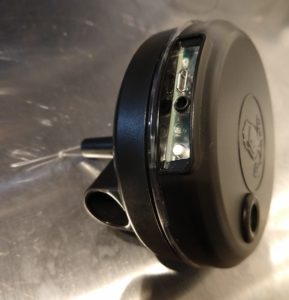
The brains of the Brew Perfect is a circuit board tucked in a black plastic housing. This takes the gravity measurements, as well as measure the temperature of the air as it passes through it. The housing is tapered to fit into a bung where an airlock would normally go in your fermentor. Inside the housing is a channel that lets you either connect a blow-off tube or an airlock. There’s a button on the housing that you push as part of programming routines, a micro-USB plug for charging the onboard battery, and an input for an optional temperature sensor. If you purchase the optional temperature sensor, the idea is you slide it down in a thermowell to monitor temperature in the body of your beer rather than the gas coming off of it.
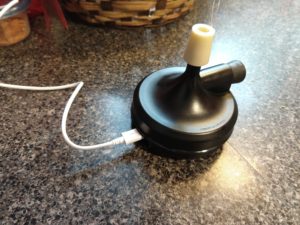 The base unit charging
The base unit charging
Hands on Review
To start off, you use the Brew Perfect app and your smartphone to get it synced up and reporting info to the cloud. It does this in a cool way that uses your smartphone screen as a kind of strobe light that talks to a sensor in the main housing. After several unsuccessful attempts, I found I had to really block ALL outside light between my phone screen and the unit to get it to work. The good news is, you only have to do this once.
The logging data gets exported to a Brew Perfect server somewhere using your home WiFi connection. You can then access that data from the app on your smartphone, or after you login to your account on their website. The graphics implementation on the app is snazzy and looks impressive to wow your homebrew buddies, “Yeah, this is my Galaxy Wheat Ale fermenting at home in my basement right now.”
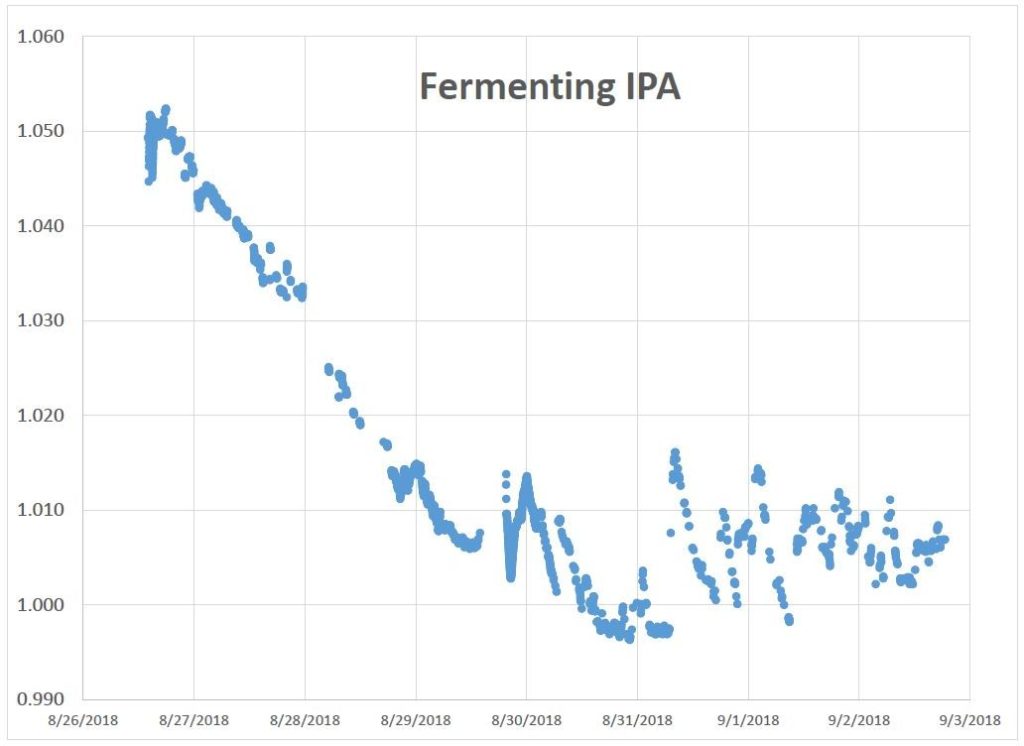 Plot of Gravity Data Through Fermentation and Dry Hopping
Plot of Gravity Data Through Fermentation and Dry Hopping
I did have a few issues with the data logging, though. The app was setup to a default data log every 10 minutes. The onboard battery was supposed to last 2 weeks at that rate. But I saw the battery life dropping rapidly at a rate that was only going to last a couple days. I found that it was logging data once or twice per minute. Occasionally it would log data every 5 minutes, 10 minutes, or in some cases only every 5 hours. Changing the sample rate in the app didn’t affect this sampling frequency. Luckily the unit works while plugged in to a USB charger, so I plugged it in and let it log away.
I had another issue with the high data sample rate. When looking at the plot of gravity over time, the app defaults to displaying 25 data points. With this plot, it drastically smooths out the data and it becomes difficult to see the subtle changes in gravity you’re looking for. If I switched it over to “All Data”, I could see that detail. However, due to the large amount of data being collected, the plot in the App couldn’t handle it after a few days and the request for all data just blanked everything out. I was able to see all data points through the Brew Perfect website on my computer, though.
Related: Our 10 Most Recent Reviews | Great Deals – Our Last 50 Finds
I also had a near heart attack at the end of my fermentation. I clicked on the button that said “Finish Brew”. I assumed this would stop logging new data, but keep all of the data I had. However, it wiped everything out and took me back to a default screen allowing me to start a new brew session if I wanted. I couldn’t find my data anywhere on the app. Luckily, I had the brew session up on my computer, and before refreshing anything, I clicked on the button to export the data to .CSV. I was able to get everything up to the last time I had reviewed the data on my laptop, which luckily was pretty much my full brew session. But I definitely recommend exporting your data periodically to .CSV so you don’t accidentally get burned by this.
At the start of fermentation, I saw no activity in my airlock attached to the Brew Perfect unit, even though I could see from the data that fermentation had clearly started hours earlier. The Brew Perfect team said this could be because the two halves of the black plastic housing might be over-tightened (they unscrew for cleaning inside). I tinkered around with this, but could never get my airlock to bubble.
Perhaps related to this unsealed issue, I found the temperature data to really just be a measure of the room temperature in my basement rather than the temperature of the beer in my fermentor. Whether I was below room temperature at the start of fermentation or above it at the end, the Brew Perfect basically just bounced around the room temperature. If you want to record the temperature, it seems the additional probe would be the way to go (although I didn’t test that).
Reviewing the data, I could see that fermentation started quickly (within 7 hours after pitching yeast), and I could see a good steady progression of the gravity dropping. I didn’t have any fermentation stalling, which was good given the several hours of blank spots in my data before I learned I needed to keep it plugged in so as not to drain the battery. As the fermentation was finishing and I was approaching my FG, I started to get a lot of ‘noise’ in the data. The gravity started a sawtooth pattern with swings in gravity of 10 – 15 points over a 6-8 hour time span. This made determining true completion of fermentation difficult to judge. Since it was swinging back and forth around the expected FG, I judged it complete and started adding my dry hops. Checking gravity with my refractometer when transferring to the keg, it confirmed that it was indeed oscillating around the FG.
Conclusions
Continuous data logging of gravity in your fermentor is something I expect will become commonplace in homebrewing. With most new technologies there is a learning curve early adopters have to deal with for the privilege of being on the leading edge. The Brew Perfect hydrometer has some nice features like WiFi connectivity for data logging and a visually pleasant app to view your fermentation. It also has some issues that I tried to capture here and any workarounds I came across so you can judge for yourself if the Brew Perfect is right for you to join the future!
Update: Brew Perfect has been discontinued, consider TILT

Homebrew Reviews and More! Check out our extensive homebrewing reviews library, our collection of resource posts and connect with us!
More Photos
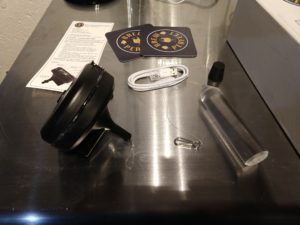
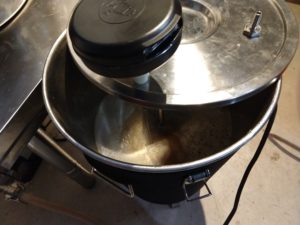
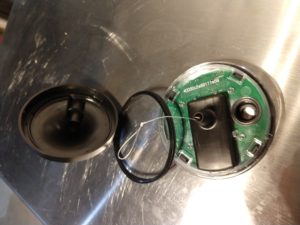
More Homebrew Finds!
Recent Deals!

10 Most Recent Homebrew Resource Posts & How-To’s!

We are Homebrew Review HQ! Our 10 Most Recent Reviews

Special Thanks to Brew Perfect for providing the unit used for evaluation in this review.
By Brad Probert. Check out Brad’s website – beersnobby.com
Inkbird ITC-308 Digital Temperature Controller| Review
review:brewperfect tag:tpr

 Screenshot showing manual gravity corrections
Screenshot showing manual gravity corrections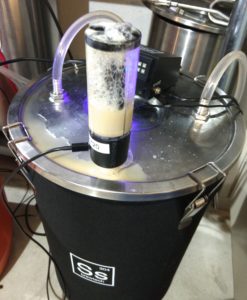
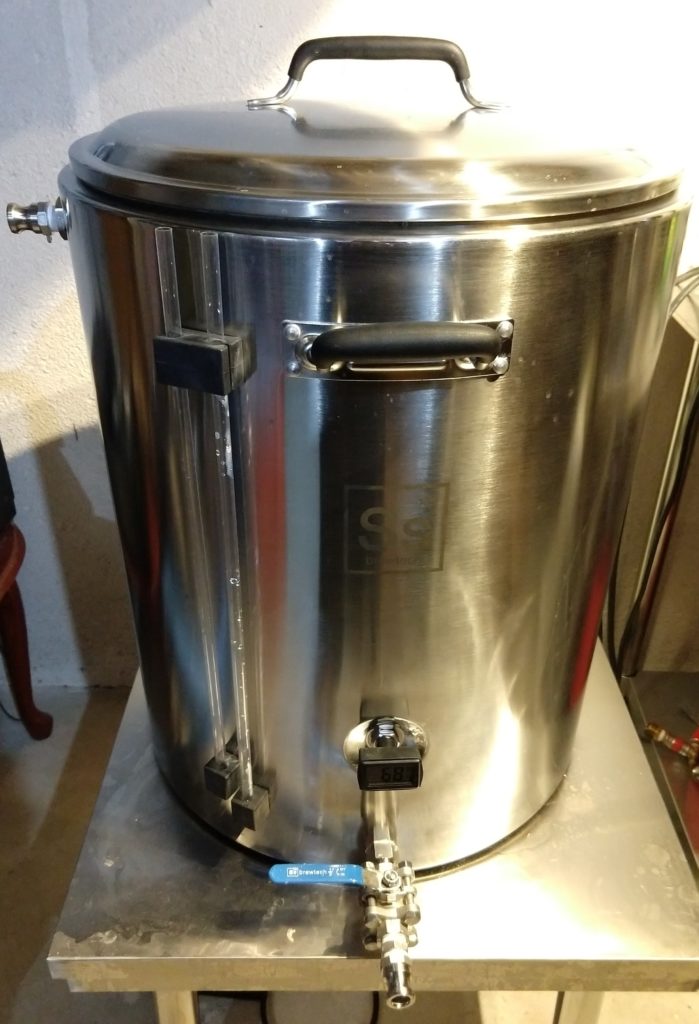 This review is by Homebrew Finds Contributor Brad Probert. Brad is an engineer, expert homebrewer and experienced reviewer. Grab a link to Brad’s website at the end of this review.
This review is by Homebrew Finds Contributor Brad Probert. Brad is an engineer, expert homebrewer and experienced reviewer. Grab a link to Brad’s website at the end of this review.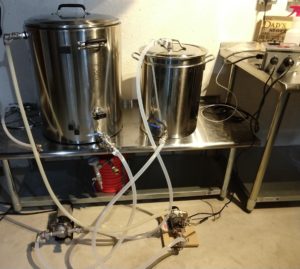 Two Vessel Setup
Two Vessel Setup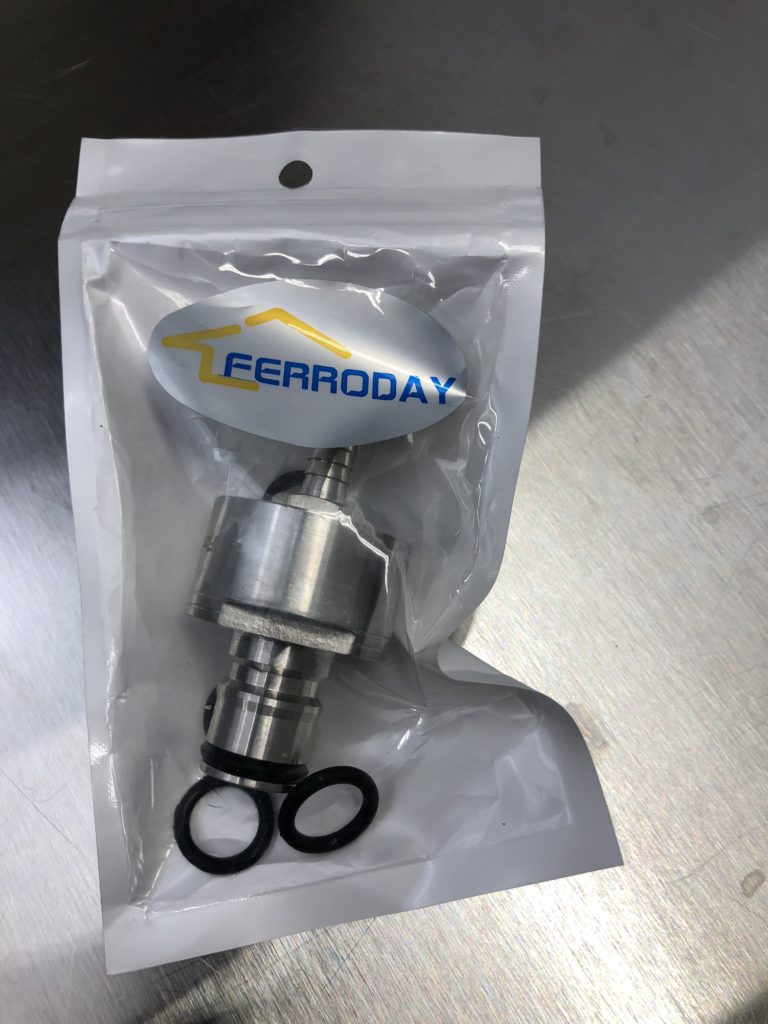
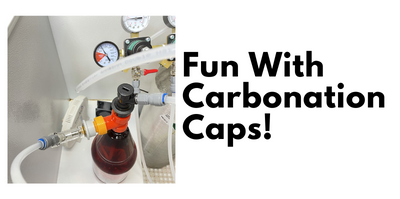
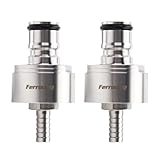

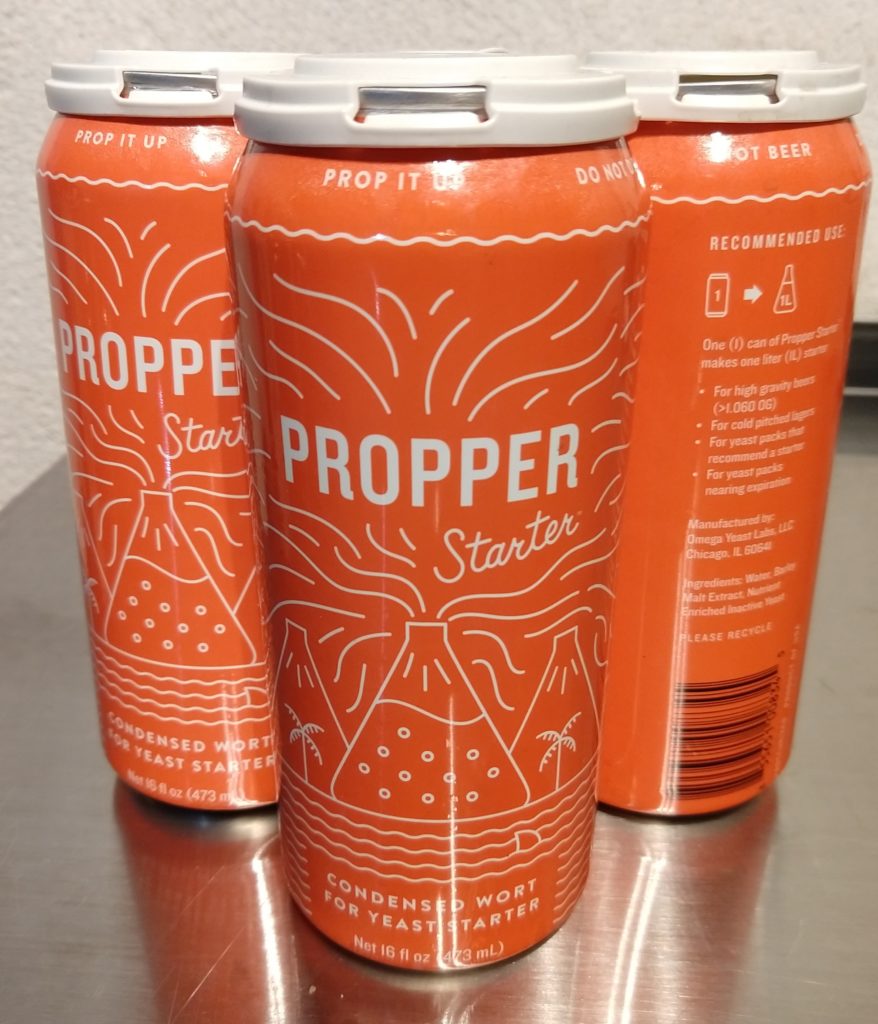 Propper Starter Canned Wort by Omega Labs
Propper Starter Canned Wort by Omega Labs




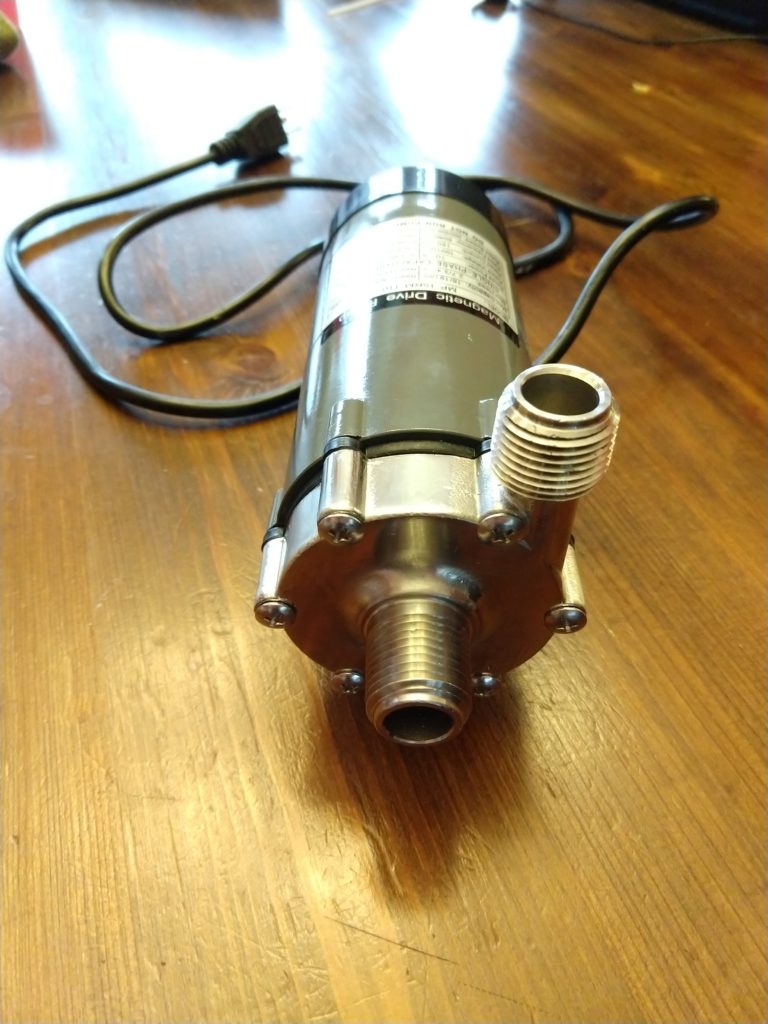
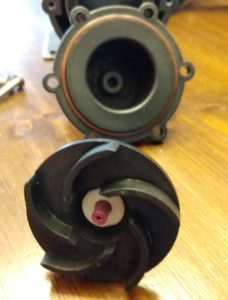 The MkII’s Magnetic Impeller
The MkII’s Magnetic Impeller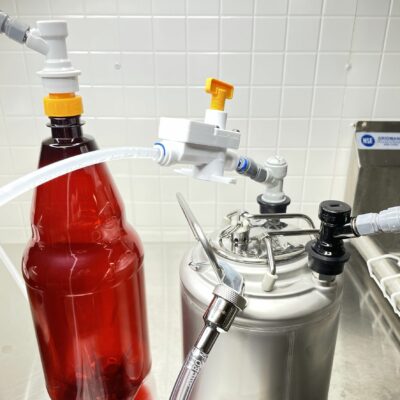
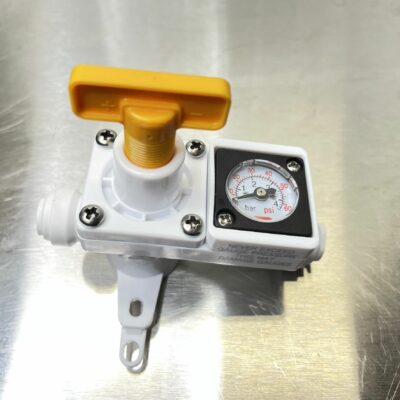
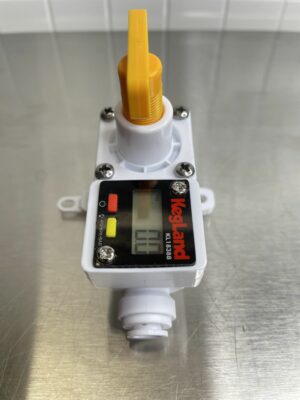






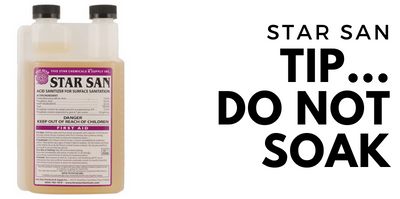
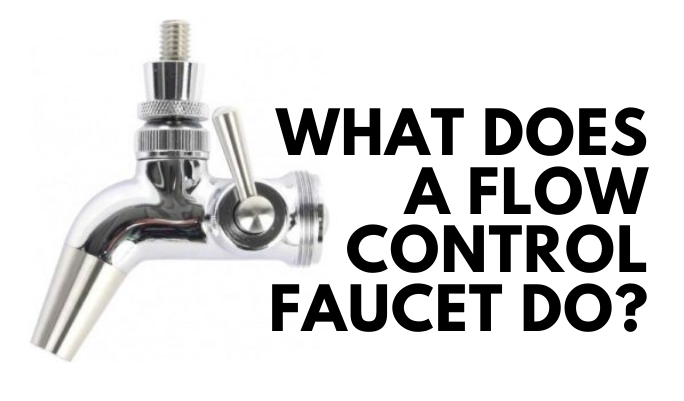
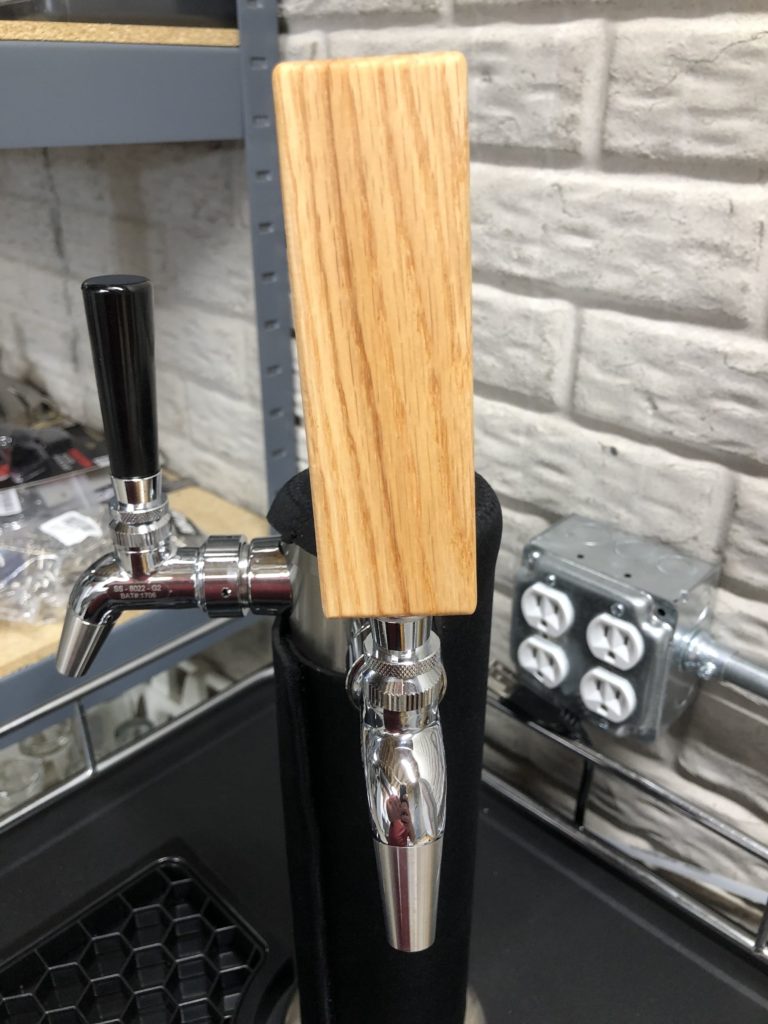
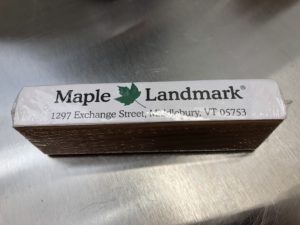
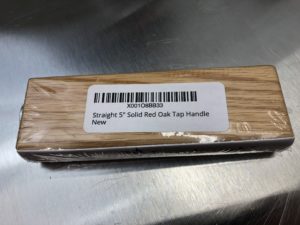 Other side includes the description and ASIN number
Other side includes the description and ASIN number











 Contents of the
Contents of the 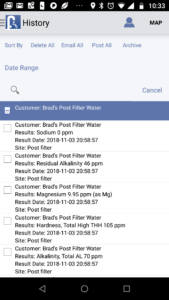 App screenshot showing test results – this is one screen of results, scrolling down shows more information
App screenshot showing test results – this is one screen of results, scrolling down shows more information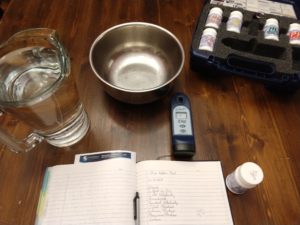 Ready for testing
Ready for testing



 MoreBeer’s
MoreBeer’s 


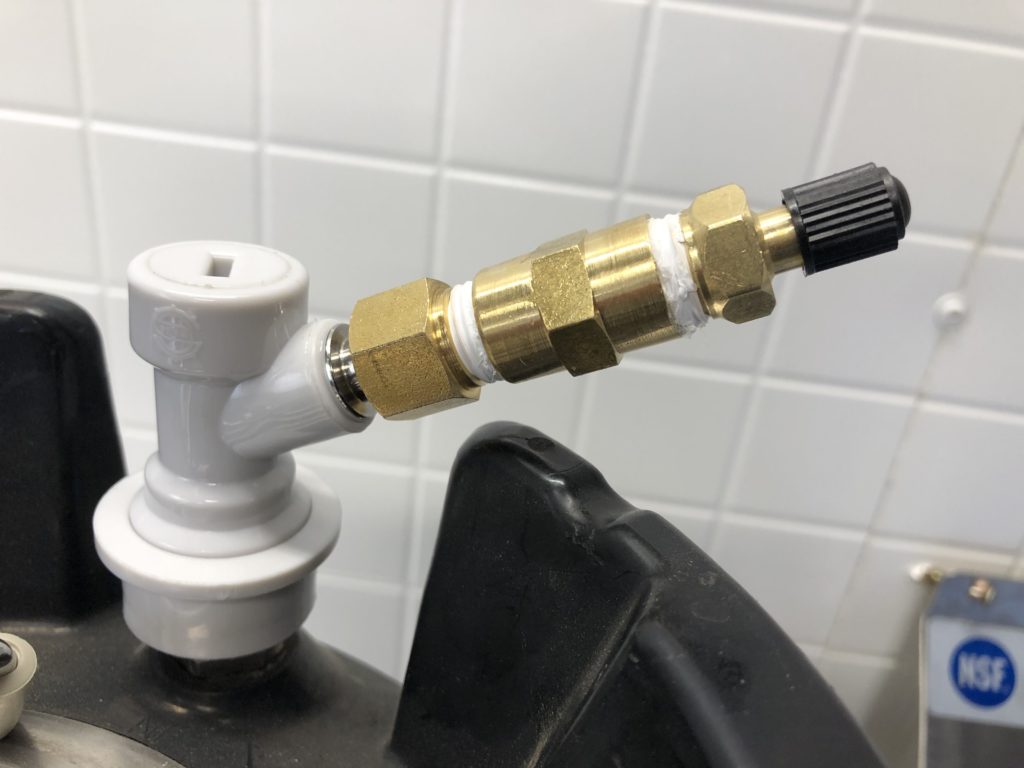
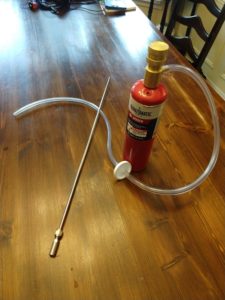 MoreBeer’s
MoreBeer’s 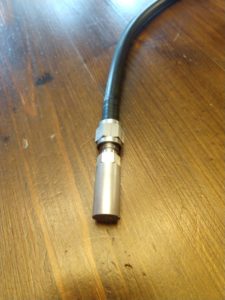 2 Micron Aeration Stone from
2 Micron Aeration Stone from 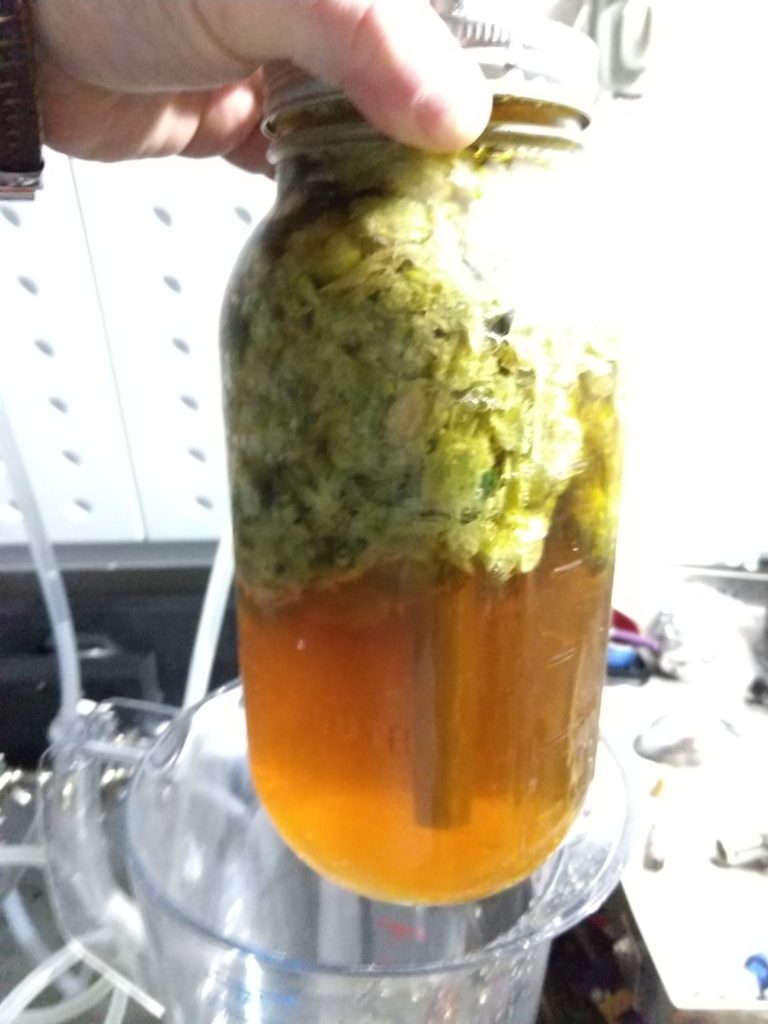
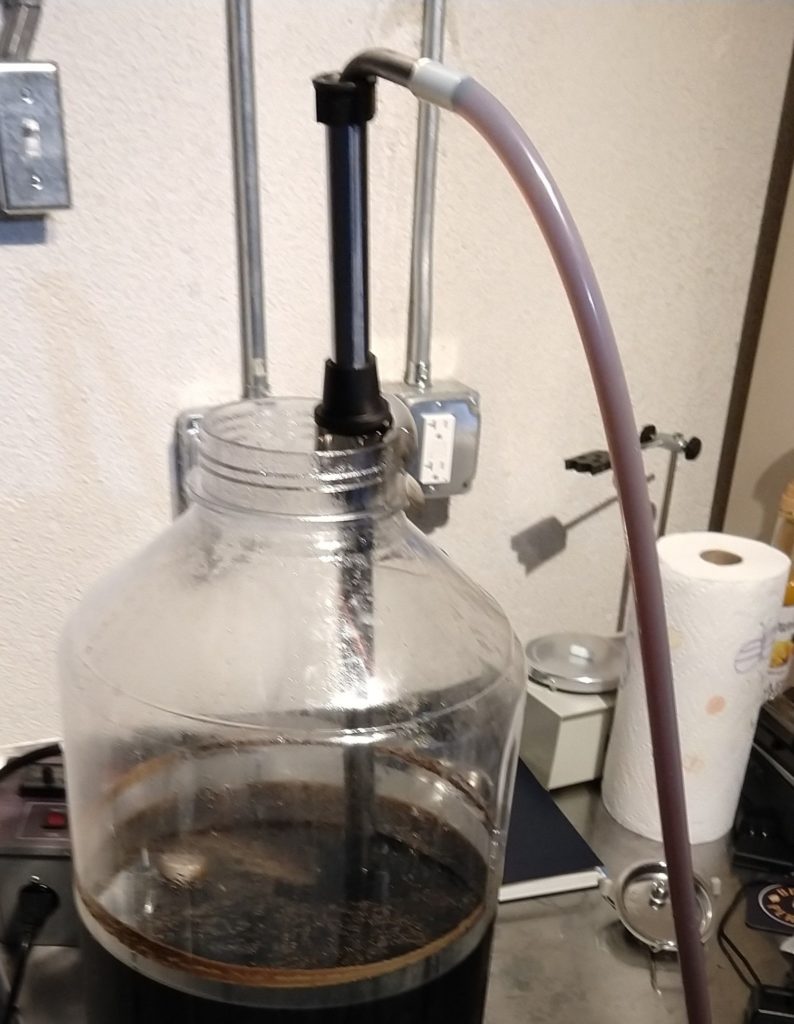
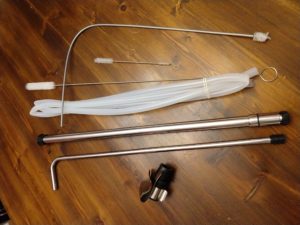 Contents of the “Complete Kit”
Contents of the “Complete Kit”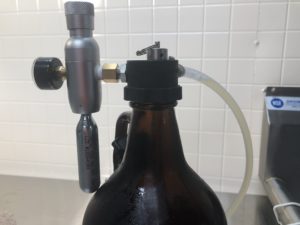
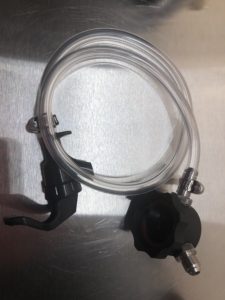 A look at the cap, faucet and tubing
A look at the cap, faucet and tubing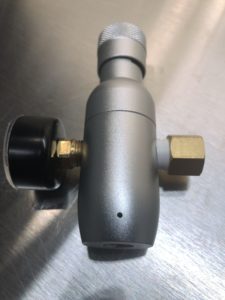 A look at the included mini CO2 regulator. Note that this is a regulator as opposed to an injector. Injectors give you no regulation of pressure other than the amount you choose to inject. This is an actual regulator that you can set to a desired pressure. That’s a key feature since this is intended to be used with compatible glass growlers.
A look at the included mini CO2 regulator. Note that this is a regulator as opposed to an injector. Injectors give you no regulation of pressure other than the amount you choose to inject. This is an actual regulator that you can set to a desired pressure. That’s a key feature since this is intended to be used with compatible glass growlers. A look at the faucet. A standard picnic/cobra style tap with a small length of tubing attached.
A look at the faucet. A standard picnic/cobra style tap with a small length of tubing attached.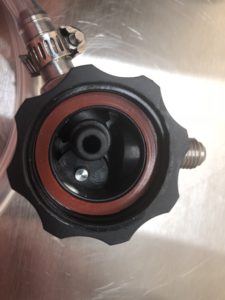 A look at the inside of the dispense cap. Notice the included o-ring/gasket. The cap feels sturdy and well built.
A look at the inside of the dispense cap. Notice the included o-ring/gasket. The cap feels sturdy and well built.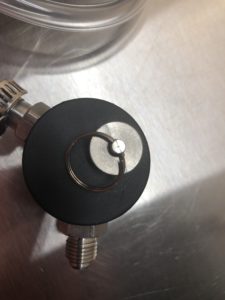 A look at the cap top-down. A PRV is installed on the top of the cap. That’s for venting to help adjust pressure or when you’re ready to remove the cap. The male flare at the bottom is for installation of the included regulator.
A look at the cap top-down. A PRV is installed on the top of the cap. That’s for venting to help adjust pressure or when you’re ready to remove the cap. The male flare at the bottom is for installation of the included regulator.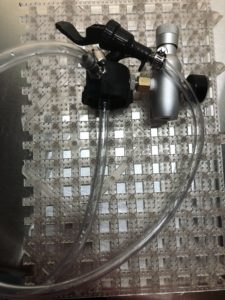 A look at the entire assembly after a soak in PBW. Note that I did not soak the regulator in PBW. That was installed after cleaning and rinsing the cap, faucet, tubing and dip tube.
A look at the entire assembly after a soak in PBW. Note that I did not soak the regulator in PBW. That was installed after cleaning and rinsing the cap, faucet, tubing and dip tube.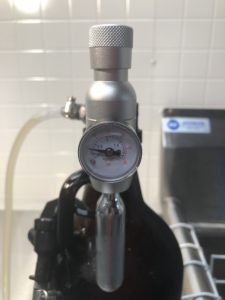 A look at the front of the CO2 pressurized growler dispenser
A look at the front of the CO2 pressurized growler dispenser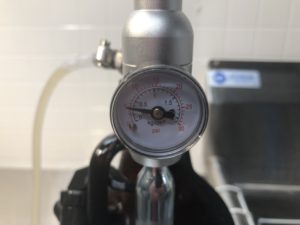 A close up of the regulator dial. The gauge on this regulator reads 30 PSI. Under no circumstances should this be set at 30 PSI. I keep it under 10 PSI. For serving I’ve found that just 1 or 2 PSI is sufficient. It’s important that you read and follow all manufacturer’s instructions for this unit. In the background:
A close up of the regulator dial. The gauge on this regulator reads 30 PSI. Under no circumstances should this be set at 30 PSI. I keep it under 10 PSI. For serving I’ve found that just 1 or 2 PSI is sufficient. It’s important that you read and follow all manufacturer’s instructions for this unit. In the background: 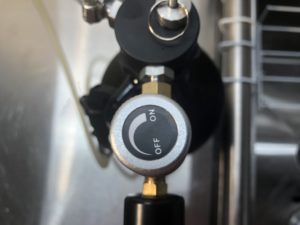 A top down look at the adjustment knob
A top down look at the adjustment knob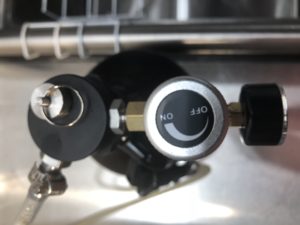 Top down look at the entire unit
Top down look at the entire unit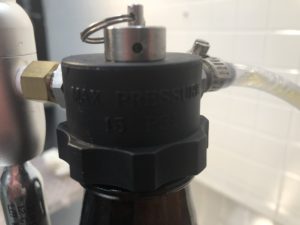 A side view look at the dispense cap. My cap says “Max Pressure 15 PSI”. I keep it under 10 PSI. For serving I’ve found that just 1 or 2 PSI is sufficient. It’s important that you read and follow all manufacturer’s instructions for this unit.
A side view look at the dispense cap. My cap says “Max Pressure 15 PSI”. I keep it under 10 PSI. For serving I’ve found that just 1 or 2 PSI is sufficient. It’s important that you read and follow all manufacturer’s instructions for this unit.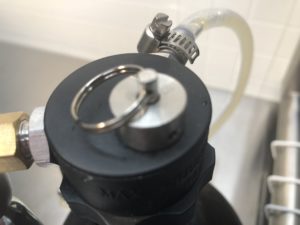
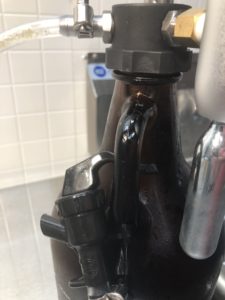 The picnic tap hangs nicely on the growler handle
The picnic tap hangs nicely on the growler handle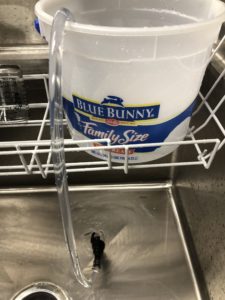
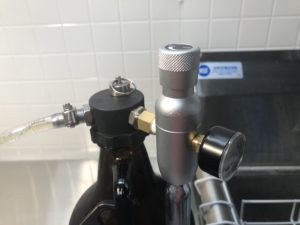
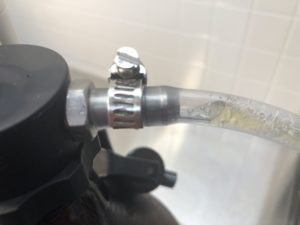
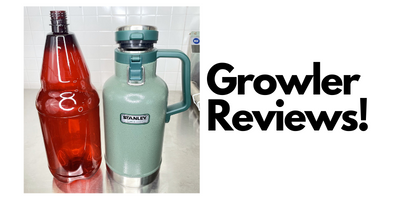
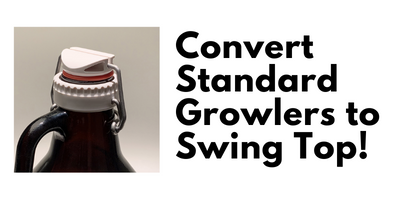
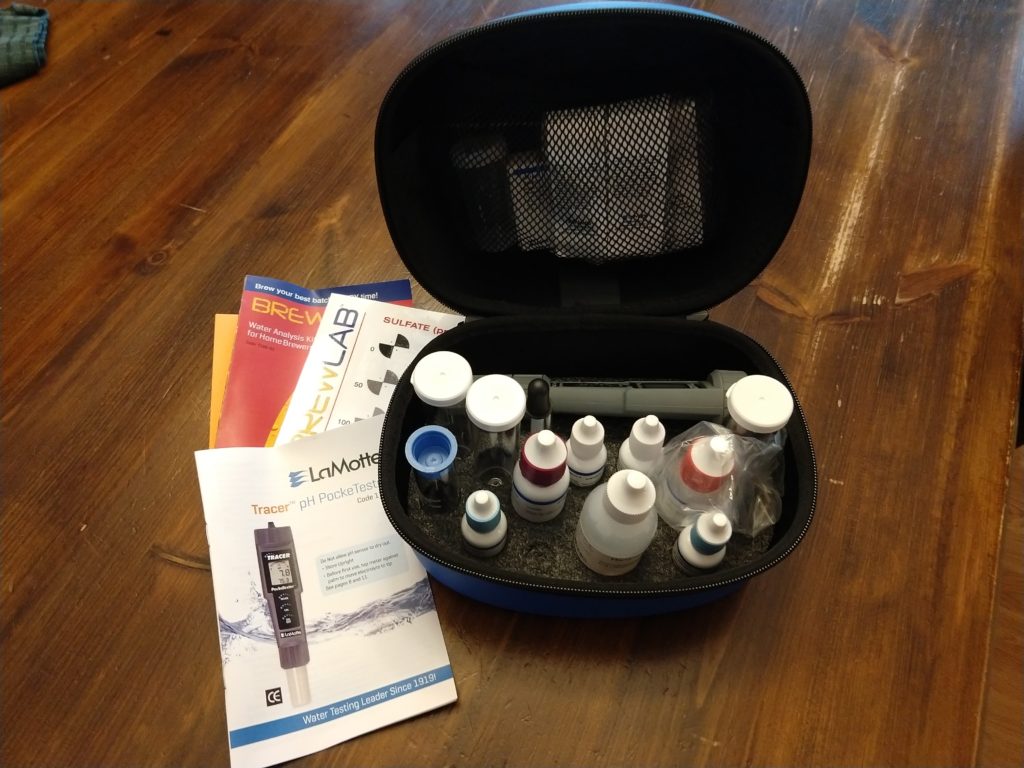
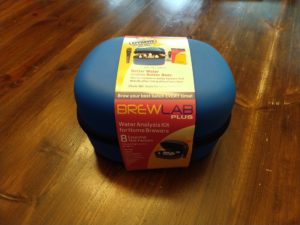 BrewLab Plus Kit – See the Palmer Brewing Solutions Approved stamp toward the top of the label
BrewLab Plus Kit – See the Palmer Brewing Solutions Approved stamp toward the top of the label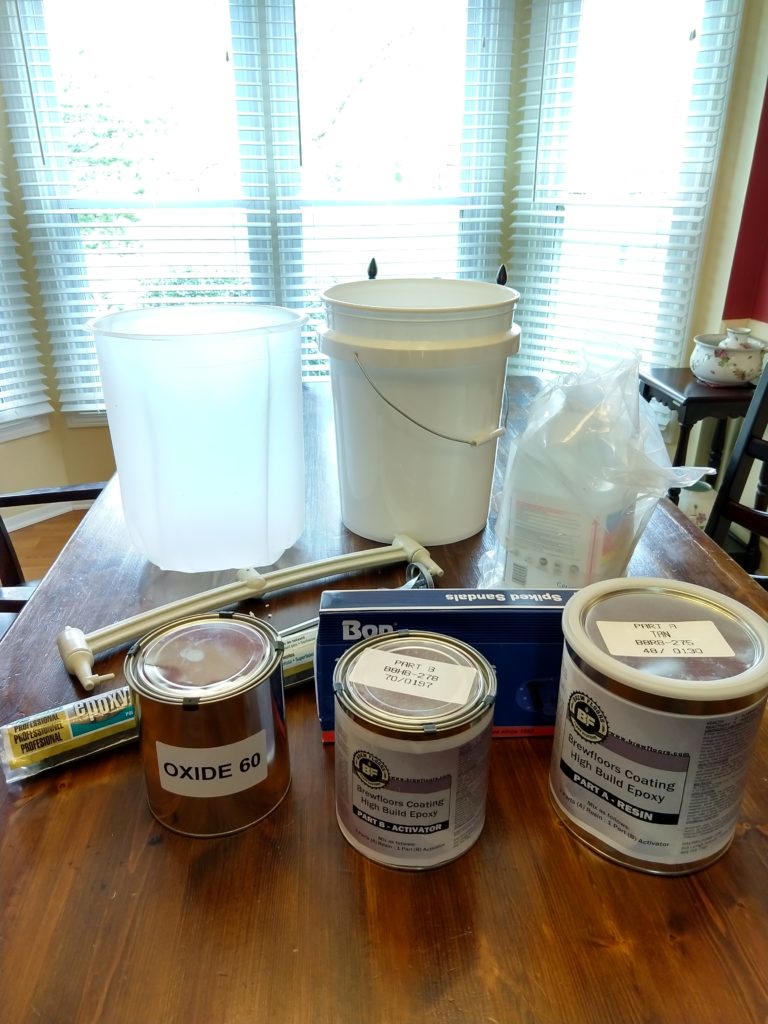



 Brew Perfect Gravity Torpedo
Brew Perfect Gravity Torpedo
 The base unit charging
The base unit charging Plot of Gravity Data Through Fermentation and Dry Hopping
Plot of Gravity Data Through Fermentation and Dry Hopping





